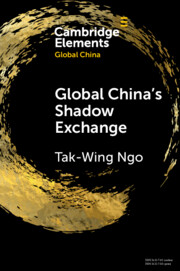Element contents
Global China's Shadow Exchange
Published online by Cambridge University Press: 05 January 2024
Summary
Keywords
- Type
- Element
- Information
- Series: Elements in Global ChinaOnline ISBN: 9781108975681Publisher: Cambridge University PressPrint publication: 01 February 2024
References
- 2
- Cited by

